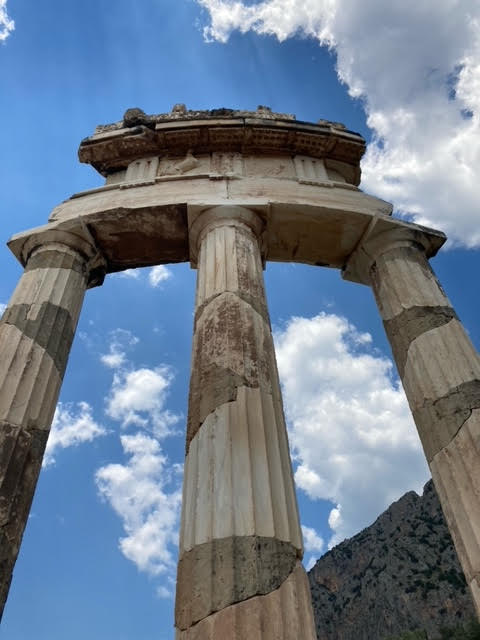Athens, city of my dreams and birthplace of democracy. Strolling the Plaka district to experience a diverse array of shops, markets, taverna, and restaurants. Drinking retsina the hue of sunlight and ouzo the color of clouds. Sumptuous local fare. Gods and heroes caper on every shop wall. Greeks are some of the friendliest people I’ve met anywhere in the world, so full of cheer, generosity and passion that you feel it like a low frequency hum wherever you go.

And the Parthenon and Temple of Athena Nike made me feel reborn. This is the closest thing to a holy site that exists for me.
Just take a gander at the Erechtheion, at the Acropolis. A tribute to the Golden Age of Athens (though built a few decades later) and dream-child of Pericles, construction was initiated by the famous sculptor and mason Phidias– the same Phidias who built the Statue of Zeus at Olympia (one of the Seven Wonders of the Ancient World.) Construction was completed around 406 BCE. The Ionic-style structure of marble was dedicated to Athena and Poseidon (who both had vied for the honor of having the city named for them). The famous porch is supported by six massive caryatid statues. This is but one of several exquisite ruins at the Acropolis, the others being the Parthenon (a Doric contrast to the Erechtheion); the Temple of Athena Nike; and the Propylaea.

Have I mentioned how wonderful the food and people are? Visiting an Athenian taverna surely ranks as one of the life’s secret joys.

Then there was the sacred act of visiting the ruins of Mycenae, with the famous Lion Gate poised atop cyclopean masonry like something out of Conan’s Hyborean Age (seriously, I kept muttering to myself, “Fire won’t burn there. No fire at all”). Legend says that Perseus himself founded this city. Relentless wind snaps around lonely trees and foundations from an astounding 3,500 years ago. An ancient cistern is like the gloomy entrance to a Bronze Age underworld, and walking into Agamemnon’s tomb (not that it’s really his tomb) is a simultaneously ominous and exhilarating event.


And of course I visited Olympia. They wouldn’t let me run the stadium naked, which would have been the historically accurate thing to do, but I did get to run it, dammit, in the birthplace of the Olympics.
The ruins of Olympia are an awe-inspiring sight to behold. Here the crumbled remains of the Temple of Zeus (one of the Seven Wonders) sits directly across from the rubble of the workshop that built it. Below Mount Kronos there’s so much history here: the gymnasium where Greek athletes would practice; the Philippeion from Philip II of Macedon commemorating his victory at the Battle of Chaeronea; the Hall of Fame (and a Hall of Shame for Olympic cheaters); and the nearby Archaeological Museum of Olympia overflowing with magnificent treasures.

Later, I visited the 2,500-year-old theater at Epidauros, set amid groves of pine, olive, and cypress. The perfection of the acoustics is no exaggeration, like a human ear rendered in eternal stone.
And of course, I went to see the Oracle of Delphi. She wasn’t in, but this site on the slopes of Mount Parnassus is sublime and awe-inspiring. Later, we stopped at the statue of Leonidas at Thermopylae for a scorching hot day at the Hot Gates. Modern commuter traffic rushes through the very spot where Spartan shields and Persian spears clashed 2,500 years ago. In the evening, the nearby modern town proved a quaint mountaintop retreat of winding streets and secret alleyways.


